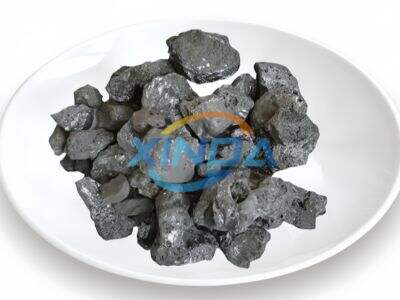Ferrosilicon is a special type of substance made by combining iron and silicon. This mix plays an essential role, as it is most commonly used in steel production and in several other industries. Over the past year, demand for ferrosilicon in Southeast Asia has pulled in a bout of ferrosilicon in that region, with domestic consumers increasingly favoring Chinese ferrosilicon. Among companies involved in this, there is Xinda — producing and exporting ferrosilicon to Southeast Asia.
Ferrosilicon for Southeast Asia is one of very fast growing demands in recent years. This growth, in turn, is mainly driven by the expansion of the steel sector, which produces various steel products in several nations, including Indonesia, Vietnam, and Thailand. These countries are trying to ramp up their steel industries and hence require greater amounts of ferrosilicon. Also Chinese ferrosilicon is also much cheaper than competitive supply ferrosilicon coming from other countries, which also adds to attractiveness to buyers in the country in the region and in Asia. It is also popular in the region because of this.
What Chinese Ferrosilicon Can Find the Opportunities and Challenges in Southeast Asia?
Southeast Asia is a golden stage for Chinese enterprises represented by Xinda to enter the local ferrosilicon manufacturing industry. The good market for ferrosilicon is due to rapid growth of the local steel industry. The demand for steel means the demand for ferrosilicon, too. Also, production cost in China is lower than many other countries. This allows them to price their products competitively, giving them the ability to entice buyers in Southeast Asia.
But there are also some headwinds for these companies seeking to sell ferrosilicon into Southeast Asia. The one biggest problem is competition. Ferrosilicon is produced in other countries too, and that means Chinese manufacturers must strive to differentiate themselves from their competition. And fluctuations in currency value can make a company’s profit harder to predict. Another factor is that import rules and regulations may change, impacting the ease of selling ferrosilicon into the region. Finally, new environmental laws are gaining importance and they can affect how ferrosilicon is manufactured and exported.
Exploring the Prospects of Chinese Ferrosilicon in Southeast Asia
In this case, Southeast Asia is regarded as a vast new market for Chinese ferrosilicon. To get an overview of how much potential lies in the Chinese ferrosilicon for the Southeast Asian markets, many factors must be considered. Economic growth in the region is one of the considerations. A booming economy requires more steel, which increases the demand in electrical steel for ferrosilicon.
Political stability is just as crucial as economic growth. When building a business empire, you should also consider the state of a nation. For example, if a country has a stable government, it is most likely that businesses will invest and grow. One more thing to think about is the availability of raw materials. If companies have enough materials to produce ferrosilicon, they can make more products. Furthermore infrastructure quality in region like roads and transportation systems can play role in supporting the ferrosilicon production and export. All in all, it is important to have an understanding of what benefits and what shortcomings selling ferrosilicon in Southeast Asia.
A Market Analysis
It is a necessary knowledge of Chinese ferrosilicon general trend and direction of development in Southeast Asian market analysis. The global economy and changes in trade policies are just some of the other factors that can impact the market. Analysts also need to consider the ties between China and SE Asian states as they may influence commerce.
In addition, the volume of steel produced and required in Southeast Asia is an important factor in determining ferrosilicon needs. When steel is in high demand, again, ferrosilicon is a key component. Market analysis will also assist in clarifying the possible competition of Chinese ferrosilicon in Southeast Asia. However, competitors from other ferrosilicon producing and exporting nations remain, making it necessary to monitor those competitors.
Chinese Ferrosilicon in Southeast Asia: The Future
Southeast Asia's outlook on Chinese ferrosilicon is exceedingly bright. Demand for ferrosilicon is expected to increase along with a blossoming steel industry in the region. The price and quality of Chinese ferrosilicon are also favourable, making it attractive for various buyers in Southeast Asia as well. This opens a significant window for companies like Xinda to grow their businesses within that market.
But there are challenges that need careful consideration as well. Example, one that is environmental which is rising in importance and both China and Southeast Asia are increasingly regulating environmental standards. As such, companies should be mindful of these issues as they may impact how ferrosilicon is manufactured and exported.
 EN
EN
 AR
AR
 NL
NL
 FR
FR
 DE
DE
 HI
HI
 IT
IT
 JA
JA
 KO
KO
 PT
PT
 RU
RU
 ES
ES
 TL
TL
 ID
ID
 SR
SR
 UK
UK
 VI
VI
 TH
TH
 TR
TR
 FA
FA
 MS
MS
 BE
BE
 AZ
AZ
 UR
UR
 BN
BN
 GU
GU
 JW
JW
 KM
KM
 LO
LO
 LA
LA
 NE
NE
 PA
PA
 TA
TA
 TE
TE
 MY
MY
 UZ
UZ
 KU
KU
 KY
KY
 LB
LB
 SD
SD






